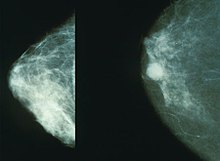
Women have been advised by their doctors to get frequent mammograms for decades. However, what if frequent (e.g., annual) mammograms result in an increased risk for breast cancer due to exposure to X-rays? After all, there is a cumulative dose from the mammograms - year after year you get exposed to a little ionizing radiation, but it builds up over time.
Dr. Seth Hardy (radiologist and Associate Professor at Penn State Univ.) discusses this issue, while referencing research by Dr. Daniel Corcos about the possibility of some breast cancers occurring from the cumulative radiation from previous mammograms. This is because radiation is a carcinogen (can cause cancer). [NOTE: studies find that over the years breast cancer treatments have so improved that any benefits of mammography screening are diminished.]
From Dr. Seth Hardy, writing at Sensible Medicine: The Ethics of Screening Mammography
The value of breast cancer screening with mammography is increasingly being questioned. Women are trying to decide what is right for them and the USPSTF is trying to decide what is worthy of reimbursement. Currently, the medical literature is at a stalemate.[1]1 ...
Screening mammography uses ionizing radiation, a known carcinogen. The dose of radiation in each exam is very low, but exposure is cumulative. Also, the absorbed dose varies with the density of the breast. Women with more glandular tissue receive a higher exposure. Thus, over decades of screening, radiation exposure may not be trivial, particularly in women with extremely dense breasts.
Across a population there is some percentage of breast cancers which are caused by screening mammography. The exact number is the subject of debate and not well studied. One article from 2011 approximates 86 cancers and 11 deaths per 100,000 women due to breast cancer screening. Another paper estimates 20-25 fatalities for 100,000 women screened starting at age 40. Due to lack of data, and ethical limitations in obtaining more data, we do not know how many breast cancers are caused by screening.
We understand screening as a ratio of harm to benefit. Mammographers justify carcinogenic risk to women through the ethical principal of utilitarianism, claiming cancers caused by radiation are justified by the number of lives saved. Unfortunately, the exact number of lives saved is unknown and it is generally accepted that over the past decades screening has had a diminishing effect given the improving treatment options for patients with cancer. Today, the harm/benefit ratio for mammography is a ratio of an unknown numerator to an unknown, but shrinking, denominator.
Excerpts from an article by Daniel Corcos, MD, PhD, which is now in preprint at bioRxiv (the preprint server for biology): Breast cancer incidence as a function of the number of previous mammograms: analysis of the NHS screening programme
The discrepancy between the protective effect of early surgery of breast cancer and the poor benefits of mammography screening programs in the long term can be explained if mammography induces breast cancer at a much higher rate than anticipated.
Mammography screening is associated in most countries with a higher incidence of breast cancer, attributed to overdiagnosis. X-ray-induced cancers can be distinguished from overdiagnosed cancers by the fact that their incidence depends on the number of previous mammograms, whereas overdiagnosis solely depends on the last screening mammogram, leading to diagnosis.
... The risk of breast cancer almost doubled after 15 years of screening. Additional cancers began to occur less than 6 years after mammography. These results are evidence that X-ray-induced carcinogenesis, rather than overdiagnosis, is the cause of the increase in breast cancer incidence.
